Exploring Alternative Frameworks for Assessing Prosperity and Recession Cycles in the Future Era.
Written by: Jeff Park
Compiled by: AididiaoJP, Foresight News
Bitcoin has historically followed a four-year cycle, which can be described as a combination of mining economics and behavioral psychology.
Let’s first review what this cycle means: each halving mechanically reduces new supply and tightens miner profit margins, forcing weaker participants out of the market, thereby reducing selling pressure. This subsequently reflexively drives up the marginal cost of new BTC, leading to a slow but structural supply contraction. As this process unfolds, fervent investors anchor on the predictable halving narrative, creating a psychological feedback loop. The loop is: early positioning, price increases, media attention going viral, retail FOMO, ultimately leading to leveraged frenzy and ending in a crash. This cycle is effective because it combines programmatic supply shocks with reflexive herd behavior that seems reliably triggered.
But this is the past Bitcoin market.
Because we know that the supply part of the equation is less effective than ever before.
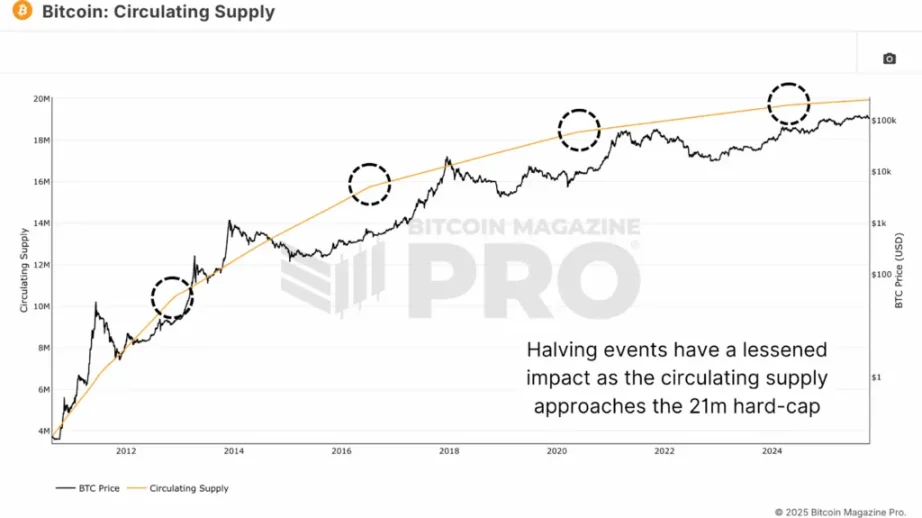
The circulating supply of Bitcoin and the diminishing marginal inflation impact
So what should we expect for the future?
I propose that in the future, Bitcoin will follow a "two-year cycle," which can be described as a combination of fund manager economics and behavioral psychology dominated by ETF footprints. Of course, I make three arbitrary and controversial assumptions here:
Investors are assessing their Bitcoin investments within a one to two-year time frame (rather than longer, as this is how most asset management firms operate in the context of liquid fund management. These are not closed-end structures holding Bitcoin in private equity/venture capital. It also unceremoniously assumes that financial advisors and registered investment advisors operate under similar frameworks);
In terms of "new sources of liquidity injection," the flow of professional investor funds through ETFs will dominate Bitcoin's liquidity, and ETFs will become the proxy metrics to track;
The selling behavior of veteran whales remains unchanged/not considered in the analysis, while they are now the largest supply decision-makers in the market.
In asset management, there are several important factors that determine fund flows. The first is co-owner risk and year-to-date gains and losses.
Regarding co-owner risk, this refers to the concern that "everyone holds the same thing," so when liquidity is one-sided, everyone needs to make the same trades, exacerbating potential trends. We typically see these phenomena in sector rotations (thematic concentration), short squeezes, pair trading (relative value), and erroneous merger arbitrage/event-driven situations. But we also see this in multi-asset domains, such as in CTA models, risk parity strategies, and of course in fiscal-driven trades where stocks represent asset inflation. These dynamic factors are difficult to model and require a lot of proprietary information about positions, making them hard for ordinary investors to access or understand.
But what is easily observable is the second point: year-to-date gains and losses.
This is a phenomenon in the asset management industry that operates on a calendar year cycle, as fund fees are standardized annually based on performance as of December 31. This is particularly evident for hedge funds, which need to standardize their attached equity before the end of the year. In other words, when volatility increases near the end of the year, and fund managers do not have enough "locked-in" gains and losses as a buffer from earlier in the year, they become more sensitive to selling their riskiest positions. This relates to whether they can secure another opportunity in 2026 or be dismissed.
In "Capital Flows, Price Pressure, and Hedge Fund Returns," Ahoniemi & Jylhä recorded that capital inflows mechanically push up returns, and these higher returns attract additional capital inflows, ultimately reversing the cycle, with the complete return reversal process taking nearly two years. They also estimated that about one-third of hedge fund reports are actually attributable to these flow-driven effects rather than the manager's skill. This creates a clear understanding of the potential cyclical dynamics, where returns are largely shaped by investor behavior and liquidity pressure, rather than just determined by the performance of underlying strategies, which dictate the latest capital flows into the Bitcoin asset class.
So considering this, imagine how fund managers assess positions like Bitcoin. Facing their investment committees, they are likely arguing that Bitcoin's annual compound growth rate is about 25%, thus needing to achieve over 50% compound growth within that time frame.
In Scenario 1 (from inception to the end of 2024), Bitcoin rises 100% in one year, so that’s good. Assuming Saylor's proposed future 30% annual compound growth rate over 20 years is the "institutional threshold," then achieving such a year early translates to 2.6 years of performance.
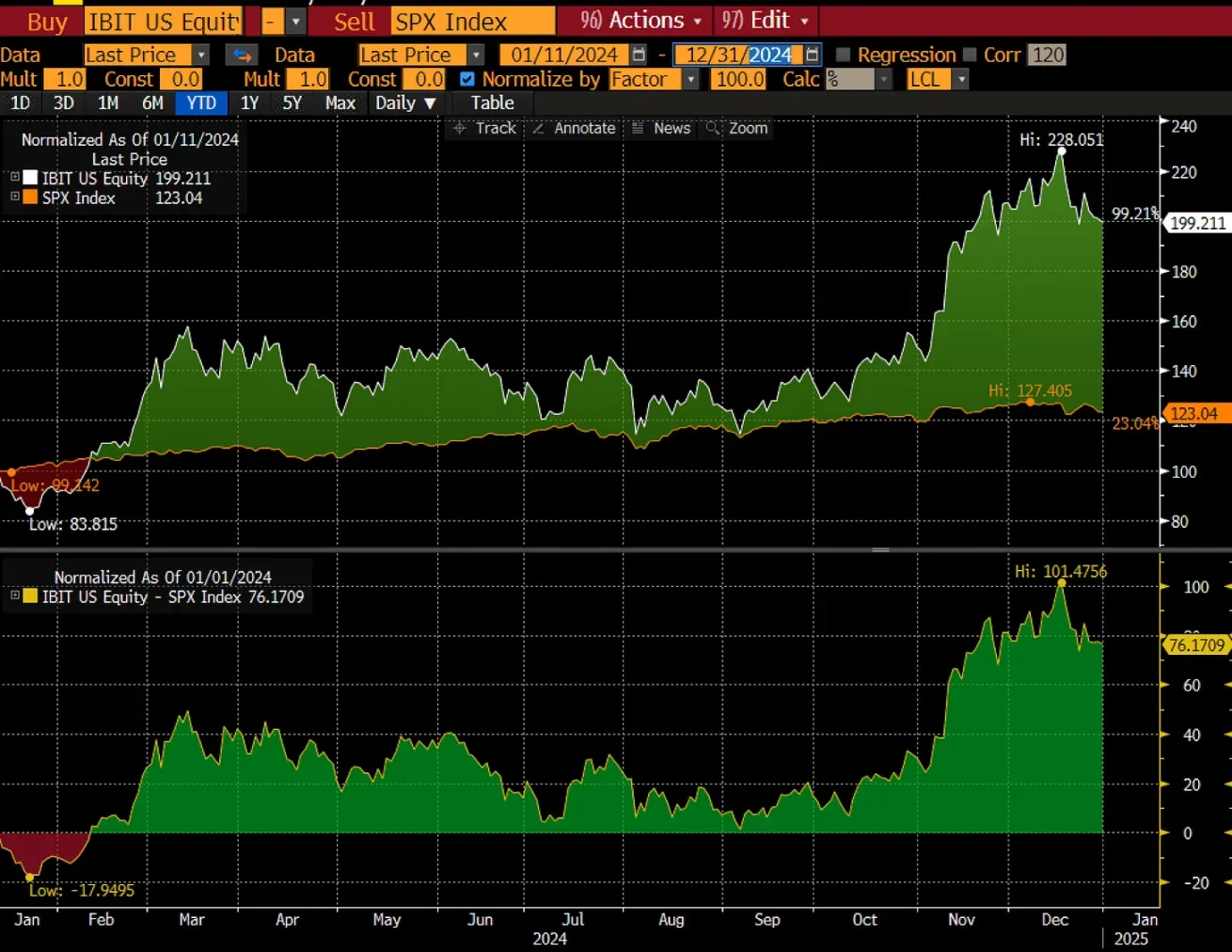
But in Scenario 2 (from the beginning of 2025 to now), Bitcoin has dropped 7%, which is not so good. These are investors who entered on January 1, 2025, and are now at a loss. These investors now need to achieve over 80% returns in the next year, or 50% returns in the next two years to meet their threshold.
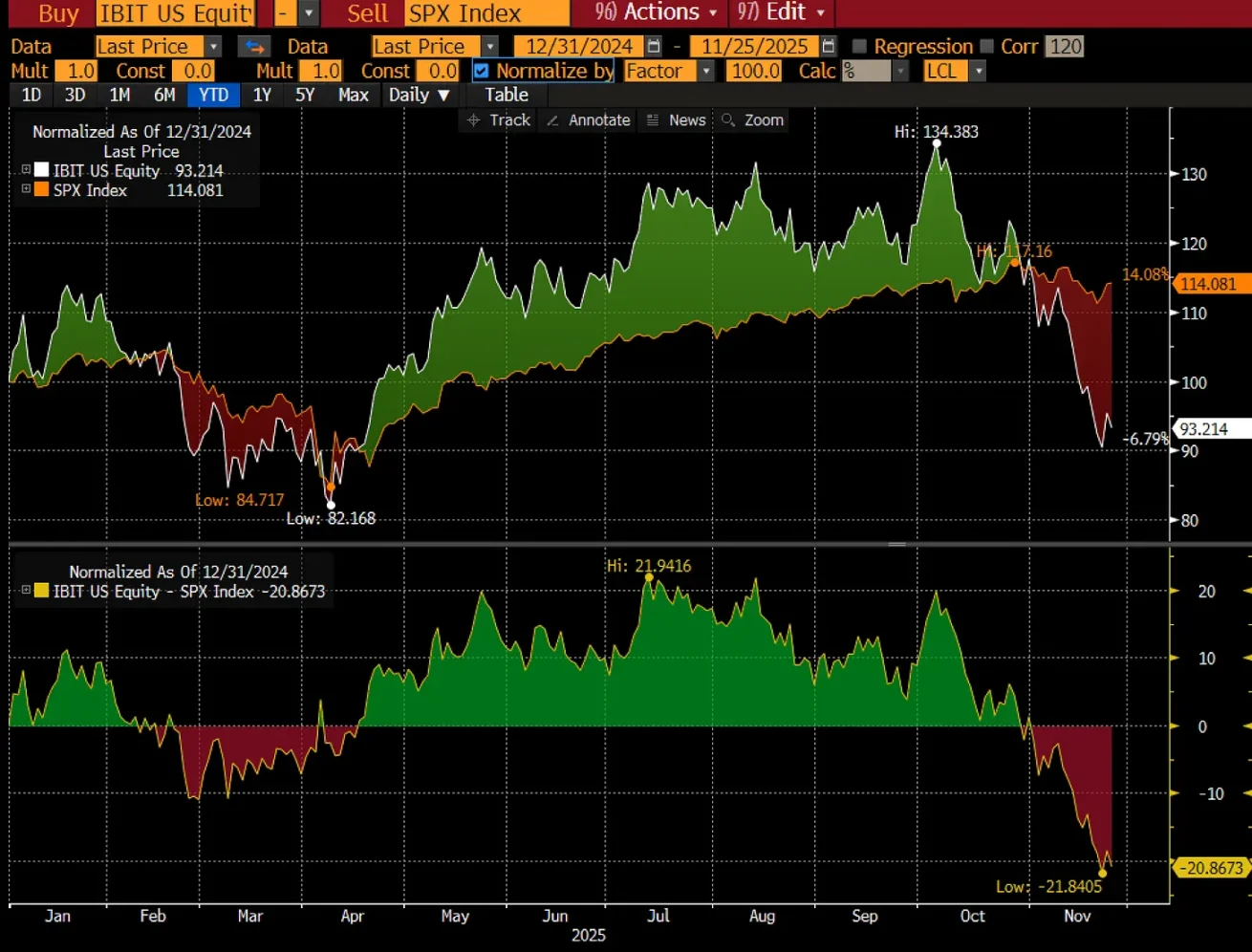
In Scenario 3, those who held Bitcoin from inception to now/2025 year-end have seen their returns rise by about 85% over approximately two years. These investors are slightly above the 70% return required to achieve a 30% annual compound growth rate within that time frame, but not as much as they would have observed at this point on December 31, 2025, which presents them with an important question: should I sell now to lock in profits, harvest my performance, and secure a win, or let it run longer?

At this point, rational investors in fund management would consider selling. This is due to the reasons I mentioned above, namely:
Fee standardization
Protecting reputation
A combination of proving "risk management" as a premium service with a continuous flywheel effect
So what does this mean?
Bitcoin is now approaching an increasingly important price of $84,000, which is the total cost basis of inflows into ETFs since inception.
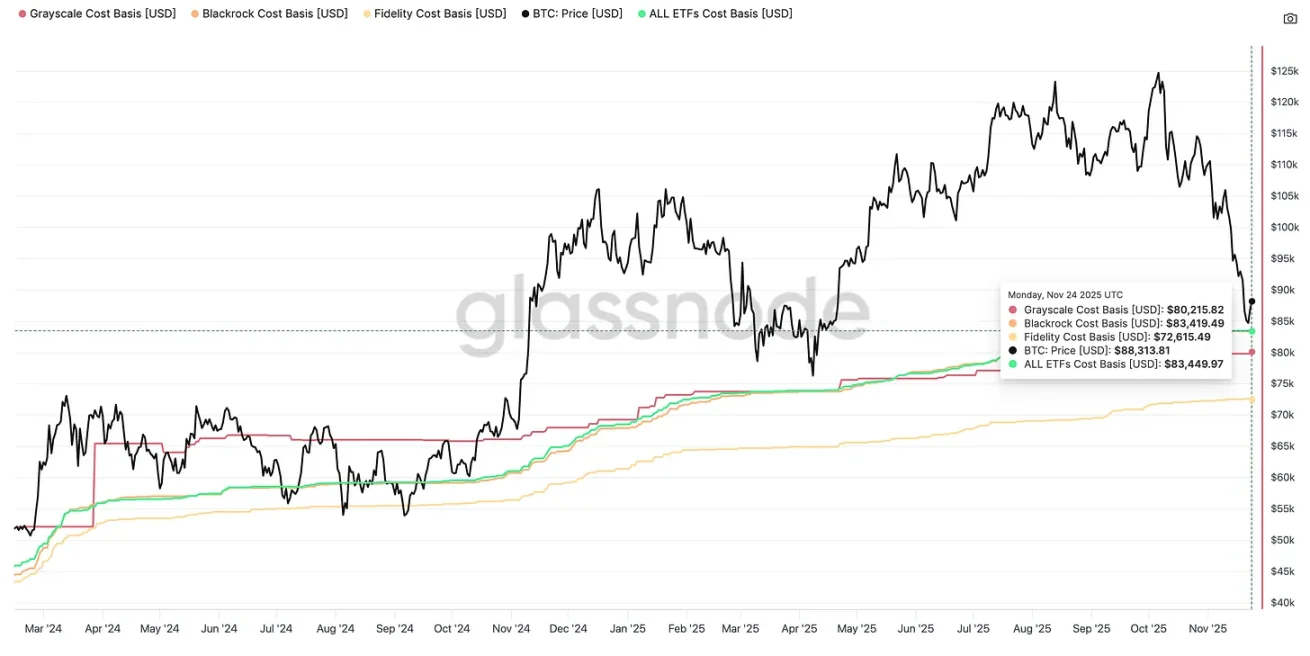
But looking at this picture alone is not complete. Take a look at this chart from CoinMarketCap, which shows the monthly net fund flows since inception.
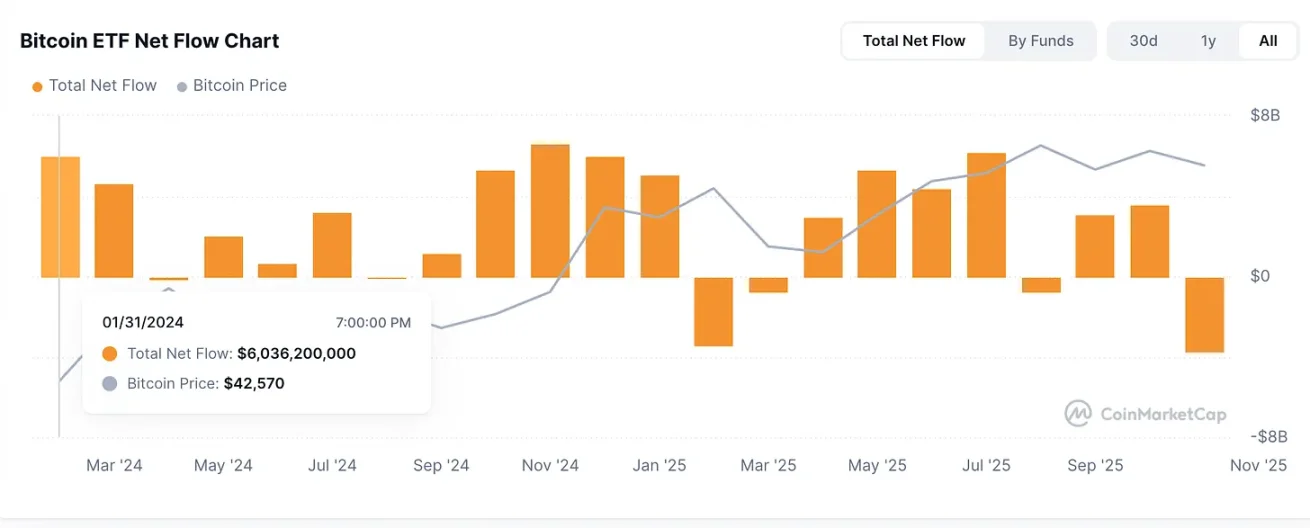
Here you can see that most of the positive gains and losses come from 2024, while almost all ETF fund flows in 2025 are in a loss state (except for March). Considering that the largest monthly inflow occurred in October 2024, when Bitcoin's price had already reached $70,000.
This can be interpreted as a bearish pattern, as those who invested the most at the end of 2024 but have not yet reached their return thresholds will face decision points in the coming year as their two-year term approaches, while those who invested in 2025 will need to perform well in 2026 to catch up, which may lead them to preemptively stop-loss exit, especially if they believe they can achieve higher investment returns elsewhere. In other words, if we enter a bear market, it will not be because of the four-year cycle, but because the two-year cycle never allowed new capital from fund managers to enter at the right entry point relative to exiting investors locking in profits.
In October 2024, the closing price was $70,000. In November 2024, the closing price was $96,000. This means that when the one-year term arrives, their thresholds are set at $91,000 and $125,000 respectively (I admit this is overly simplistic as it does not consider monthly prices and needs to be adjusted more appropriately). If you take a similar approach for June 2025 (which is the month with the largest inflow year-to-date), then a price of $107,000 means that by June 2026, $140,000 becomes a threshold. You will either succeed in reaching it or fail again. By now, you can likely intuitively understand that a comprehensive analysis combines all these fund flows with time-weighted averages.
As shown below, we are at a turning point, and if we drop 10% from here, the asset management scale of Bitcoin ETFs could return to the level we started at the beginning of the year ($103.5 billion).

All of this indicates that monitoring not only the average cost basis of ETF holders but also the moving average of gains and losses by entry period is becoming increasingly important. I believe these will become sources of pressure for liquidity supply and circuit breaker mechanisms in future Bitcoin price behavior that are more significant than the historical four-year cycle. This will lead to a "dynamic two-year cycle."
The second most important conclusion here is that if Bitcoin's price does not fluctuate, but time moves forward (whether you like it or not, it will!), this is ultimately unfavorable for Bitcoin in the institutional era, as fund managers' investment returns are declining. Asset management is a business about "cost of capital" and relative opportunity. So if Bitcoin's investment returns decline, not because it rises or falls, but because it consolidates, this is still unfavorable for Bitcoin and will lead investors to sell when their investment returns are compressed below 30%.
In summary, the four-year cycle is certainly over, but the exit of old tricks does not mean there are no new tricks to play. Those who can understand this specific behavioral psychology will find a new cycle to operate within. This is more challenging, as it requires a more dynamic understanding of capital flows in the context of cost basis backgrounds, but ultimately, it will reaffirm the truth about Bitcoin, which will always fluctuate based on marginal demand and marginal supply as well as profit-taking behavior.
It’s just that the buyers have changed, and the supply itself has become less important. The good news is: these buyers, acting as agents of others' funds, are more predictable, and the diminishing importance of supply constraints means that more predictable factors will become more dominant.
免责声明:本文章仅代表作者个人观点,不代表本平台的立场和观点。本文章仅供信息分享,不构成对任何人的任何投资建议。用户与作者之间的任何争议,与本平台无关。如网页中刊载的文章或图片涉及侵权,请提供相关的权利证明和身份证明发送邮件到support@aicoin.com,本平台相关工作人员将会进行核查。




